10.7: Creating your own fitness plan
- Page ID
- 8804
\( \newcommand{\vecs}[1]{\overset { \scriptstyle \rightharpoonup} {\mathbf{#1}} } \)
\( \newcommand{\vecd}[1]{\overset{-\!-\!\rightharpoonup}{\vphantom{a}\smash {#1}}} \)
\( \newcommand{\id}{\mathrm{id}}\) \( \newcommand{\Span}{\mathrm{span}}\)
( \newcommand{\kernel}{\mathrm{null}\,}\) \( \newcommand{\range}{\mathrm{range}\,}\)
\( \newcommand{\RealPart}{\mathrm{Re}}\) \( \newcommand{\ImaginaryPart}{\mathrm{Im}}\)
\( \newcommand{\Argument}{\mathrm{Arg}}\) \( \newcommand{\norm}[1]{\| #1 \|}\)
\( \newcommand{\inner}[2]{\langle #1, #2 \rangle}\)
\( \newcommand{\Span}{\mathrm{span}}\)
\( \newcommand{\id}{\mathrm{id}}\)
\( \newcommand{\Span}{\mathrm{span}}\)
\( \newcommand{\kernel}{\mathrm{null}\,}\)
\( \newcommand{\range}{\mathrm{range}\,}\)
\( \newcommand{\RealPart}{\mathrm{Re}}\)
\( \newcommand{\ImaginaryPart}{\mathrm{Im}}\)
\( \newcommand{\Argument}{\mathrm{Arg}}\)
\( \newcommand{\norm}[1]{\| #1 \|}\)
\( \newcommand{\inner}[2]{\langle #1, #2 \rangle}\)
\( \newcommand{\Span}{\mathrm{span}}\) \( \newcommand{\AA}{\unicode[.8,0]{x212B}}\)
\( \newcommand{\vectorA}[1]{\vec{#1}} % arrow\)
\( \newcommand{\vectorAt}[1]{\vec{\text{#1}}} % arrow\)
\( \newcommand{\vectorB}[1]{\overset { \scriptstyle \rightharpoonup} {\mathbf{#1}} } \)
\( \newcommand{\vectorC}[1]{\textbf{#1}} \)
\( \newcommand{\vectorD}[1]{\overrightarrow{#1}} \)
\( \newcommand{\vectorDt}[1]{\overrightarrow{\text{#1}}} \)
\( \newcommand{\vectE}[1]{\overset{-\!-\!\rightharpoonup}{\vphantom{a}\smash{\mathbf {#1}}}} \)
\( \newcommand{\vecs}[1]{\overset { \scriptstyle \rightharpoonup} {\mathbf{#1}} } \)
\( \newcommand{\vecd}[1]{\overset{-\!-\!\rightharpoonup}{\vphantom{a}\smash {#1}}} \)
\(\newcommand{\avec}{\mathbf a}\) \(\newcommand{\bvec}{\mathbf b}\) \(\newcommand{\cvec}{\mathbf c}\) \(\newcommand{\dvec}{\mathbf d}\) \(\newcommand{\dtil}{\widetilde{\mathbf d}}\) \(\newcommand{\evec}{\mathbf e}\) \(\newcommand{\fvec}{\mathbf f}\) \(\newcommand{\nvec}{\mathbf n}\) \(\newcommand{\pvec}{\mathbf p}\) \(\newcommand{\qvec}{\mathbf q}\) \(\newcommand{\svec}{\mathbf s}\) \(\newcommand{\tvec}{\mathbf t}\) \(\newcommand{\uvec}{\mathbf u}\) \(\newcommand{\vvec}{\mathbf v}\) \(\newcommand{\wvec}{\mathbf w}\) \(\newcommand{\xvec}{\mathbf x}\) \(\newcommand{\yvec}{\mathbf y}\) \(\newcommand{\zvec}{\mathbf z}\) \(\newcommand{\rvec}{\mathbf r}\) \(\newcommand{\mvec}{\mathbf m}\) \(\newcommand{\zerovec}{\mathbf 0}\) \(\newcommand{\onevec}{\mathbf 1}\) \(\newcommand{\real}{\mathbb R}\) \(\newcommand{\twovec}[2]{\left[\begin{array}{r}#1 \\ #2 \end{array}\right]}\) \(\newcommand{\ctwovec}[2]{\left[\begin{array}{c}#1 \\ #2 \end{array}\right]}\) \(\newcommand{\threevec}[3]{\left[\begin{array}{r}#1 \\ #2 \\ #3 \end{array}\right]}\) \(\newcommand{\cthreevec}[3]{\left[\begin{array}{c}#1 \\ #2 \\ #3 \end{array}\right]}\) \(\newcommand{\fourvec}[4]{\left[\begin{array}{r}#1 \\ #2 \\ #3 \\ #4 \end{array}\right]}\) \(\newcommand{\cfourvec}[4]{\left[\begin{array}{c}#1 \\ #2 \\ #3 \\ #4 \end{array}\right]}\) \(\newcommand{\fivevec}[5]{\left[\begin{array}{r}#1 \\ #2 \\ #3 \\ #4 \\ #5 \\ \end{array}\right]}\) \(\newcommand{\cfivevec}[5]{\left[\begin{array}{c}#1 \\ #2 \\ #3 \\ #4 \\ #5 \\ \end{array}\right]}\) \(\newcommand{\mattwo}[4]{\left[\begin{array}{rr}#1 \amp #2 \\ #3 \amp #4 \\ \end{array}\right]}\) \(\newcommand{\laspan}[1]{\text{Span}\{#1\}}\) \(\newcommand{\bcal}{\cal B}\) \(\newcommand{\ccal}{\cal C}\) \(\newcommand{\scal}{\cal S}\) \(\newcommand{\wcal}{\cal W}\) \(\newcommand{\ecal}{\cal E}\) \(\newcommand{\coords}[2]{\left\{#1\right\}_{#2}}\) \(\newcommand{\gray}[1]{\color{gray}{#1}}\) \(\newcommand{\lgray}[1]{\color{lightgray}{#1}}\) \(\newcommand{\rank}{\operatorname{rank}}\) \(\newcommand{\row}{\text{Row}}\) \(\newcommand{\col}{\text{Col}}\) \(\renewcommand{\row}{\text{Row}}\) \(\newcommand{\nul}{\text{Nul}}\) \(\newcommand{\var}{\text{Var}}\) \(\newcommand{\corr}{\text{corr}}\) \(\newcommand{\len}[1]{\left|#1\right|}\) \(\newcommand{\bbar}{\overline{\bvec}}\) \(\newcommand{\bhat}{\widehat{\bvec}}\) \(\newcommand{\bperp}{\bvec^\perp}\) \(\newcommand{\xhat}{\widehat{\xvec}}\) \(\newcommand{\vhat}{\widehat{\vvec}}\) \(\newcommand{\uhat}{\widehat{\uvec}}\) \(\newcommand{\what}{\widehat{\wvec}}\) \(\newcommand{\Sighat}{\widehat{\Sigma}}\) \(\newcommand{\lt}{<}\) \(\newcommand{\gt}{>}\) \(\newcommand{\amp}{&}\) \(\definecolor{fillinmathshade}{gray}{0.9}\)If you’d like to get stronger or faster, lose weight, or just improve the quality of your life, consider creating a personal fitness plan to meet your goals. There are many kinds of possible plans and most incorporate a mix of aerobic, resistance, and flexibility exercises. Assess your level of fitness and craft a plan suited to you
Part 1: Assessing your Fitness Level

Start with the basics. You’ve decided to get fit — that’s a great first step. But don’t just jump in without giving it some thought. Start with simple things: Is there anything stopping you from getting fit? Do you have any health issues? Should you talk to a doctor first?
- You probably don’t need to talk to a doctor if you’re under 50 and in good health, but it is always recommended before starting a new exercise program.
- If you’re over 50 or have health issues — like high blood pressure, heart problems, dizzy spells, or arthritis — talk to your doctor first.
- Keep in mind that balance and strength decrease as you age. This can limit your ability to exercise or make injuries more likely, and harder to heal. But, by exercising with caution and a little guidance, you can improve these things through exercise.
- When in doubt, talk to a physician. Your physician can indicate any activities you should steer away from.
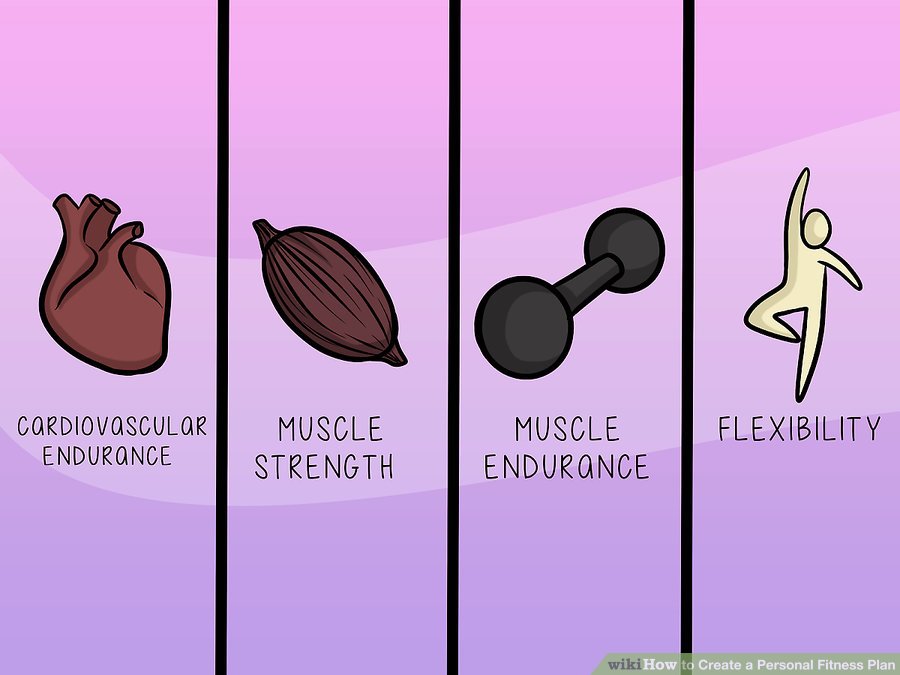
Test your current fitness level. Basic fitness is a mix of four things: cardiovascular endurance, muscle strength, muscle endurance, and flexibility. How do you measure up? Test yourself to see where you’re fit and where you stand to improve. You’ll need a watch, a measuring tape, a yardstick, tape, and a scale.
- Take a brisk 1 mile (1.6 km) walk to test your cardio health. Before you start, take your pulse rate in beats per minute and record the time. Take your pulse again afterwards and note how long it took you.
- To get your pulse rate, just put your index and middle fingers on the side of your neck. Count the beats for 10 seconds and multiply by six.
- To test muscular strength, count how many push-ups you can do until you are unable to perform any more push-ups with correct form. If you are a woman, you can do modified push-ups (bend your knees) or classic push-ups. Men should do classic push-ups from the plank position. Record the number.
- For flexibility, secure a yardstick to the floor with some tape at the 15 inch mark. Sit next to the yardstick, with your feet roughly even with the tape. Reach forward as far as you can, holding the position long enough to note how far you were able to reach. Do this exercise three times, recording your farthest reach.
- Now for body composition: waist and Body Mass Index. First measure and record your waist circumference around the body at the level of your bellybutton — where your waist is most narrow. To get your BMI (a rough indicator of body fat percentage), use an online calculator or divide your weight in lbs. by your height in inches, squared, times 703. If you're using metric, BMI = (Weight in Kilograms / (Height in Meters x Height in Meters))
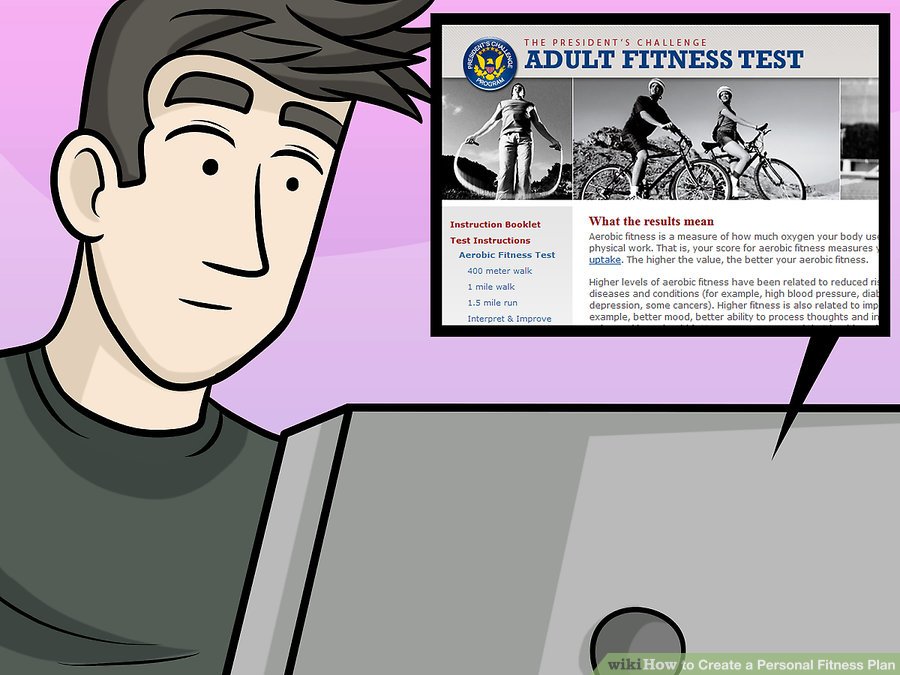
Figure out your goals. What to make of these test results? Well, they should give a rough guide to health based on averages for your age and sex, and also what your fitness plan should focus on. Plug in your results on the President’s Challenge Adult Fitness Test website to see where you stand. The website will show you your results and your score in terms of your percentile score, which represents the average achievement of people in your age group performing the test.
- The mile walk measures your cardio fitness. Healthy adults should reach at least the 25 percentile. If you score below this, you may want a fitness plan with an emphasis on aerobic exercise.
- Scoring in the bottom quarter for push-ups means that you probably do not have developed upper body muscle strength — consider adding resistance training to your plan.
- The reach-and-stretch exercise measures how much flexibility your joints and muscles have. A poor result means that you should consider doing stretching exercises like yoga or pilates as part of your program. Ladies usually have a bit more flexibility than men. A woman aged 32 who stretches 12 inches scores in the 5th percentile, where a similar score for a man is in the 25th percentile.
- Finally, a BMI of 25 or more may mean that you are overweight and at higher risk for things like heart disease, high blood pressure, or diabetes. General weight loss might be a goal for your program.
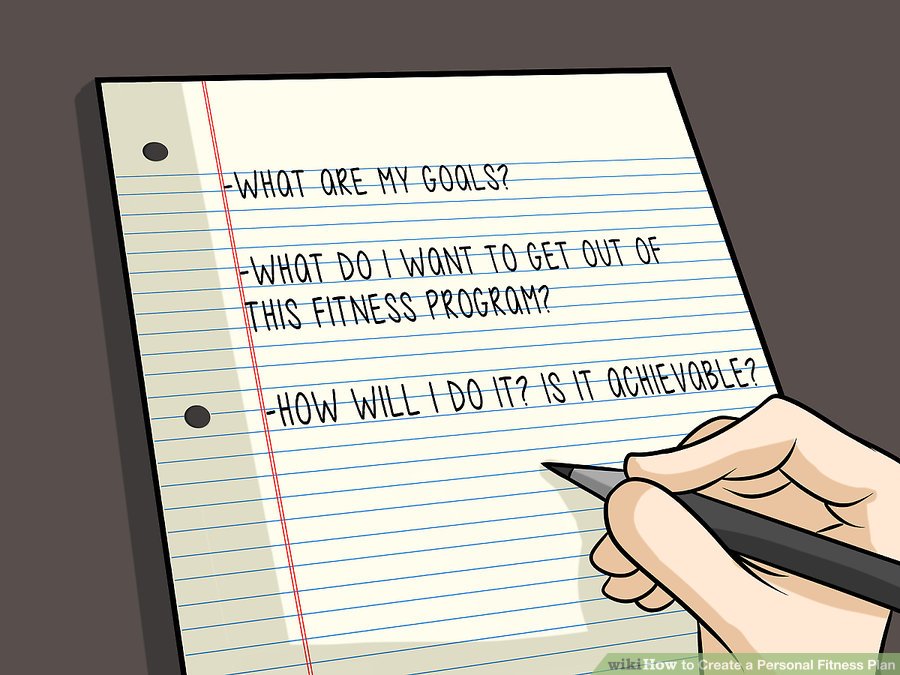
Plan it out. Give yourself added encouragement by planning your program in detail. You can either do this on your own or with outside help. A structured plan will allow you to set goals and stay on track.
- Try writing out your plan on paper, for example. Ask specific questions: What are my goals? What do I want to get out of this fitness program? How will I do it? Is it achievable?
- Be specific in your answers. For instance, do you want to be able to run for 30 minutes four times per week? Or do you want to lose 5 pounds in a month? Just saying "I want to get fit" doesn't give you a concrete, measurable goal to work toward. The more specific you can be, the easier it will be for you to know when you've met your goals.
- Post your plan where you’ll see it every day, like in your office or on the bathroom mirror.
- If you want, you can also get a personal trainer. Personal trainers are fitness experts who will make sure you are using proper form while exercising, doing exercises that are appropriate for your fitness level, help you set goals and motivate you to reach them.
Part 2: Creating a Cardio Plan
Pick exercises you can do and enjoy. Cardio is the bread and butter of fitness plans. When you do cardio, you work big muscle groups in your body, your heart rate rises, and you breathe faster and more deeply.
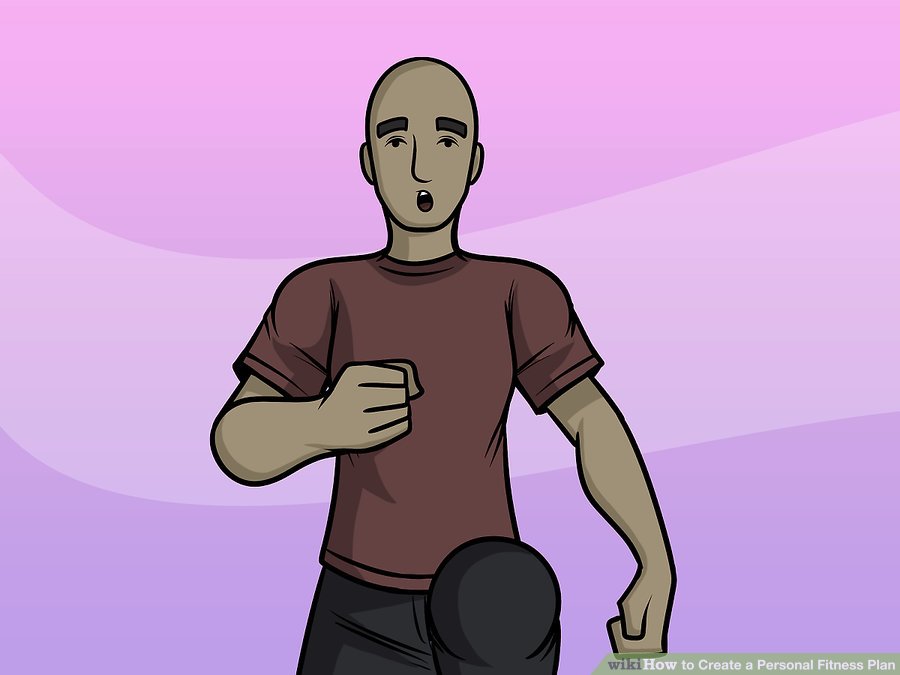
Cardio exercise will strengthen your heart, increase your endurance, and burn calories. It will also boost your mood and help you sleep better.
- Cardio is also known as aerobic exercise. The idea is to elevate your heart rate and breathing rate.
- Walking, running, rowing, swimming, bicycling, and dancing are all cardio exercises. So are most team sports, martial arts, and even golfing.
- Choose exercises that you like, but also make sure you are physically able to do them. Running is hard on the knees and feet, for instance, so you if you have bad knees you might need a lower impact exercise like brisk walking, cycling or swimming.
- Also keep in mind that you’ll be working out often, so you may want to have several exercises and alternate. For instance, you might ride your bike, swim, and play golf on different days one week. Or, you might play soccer, run, and in-line skate.
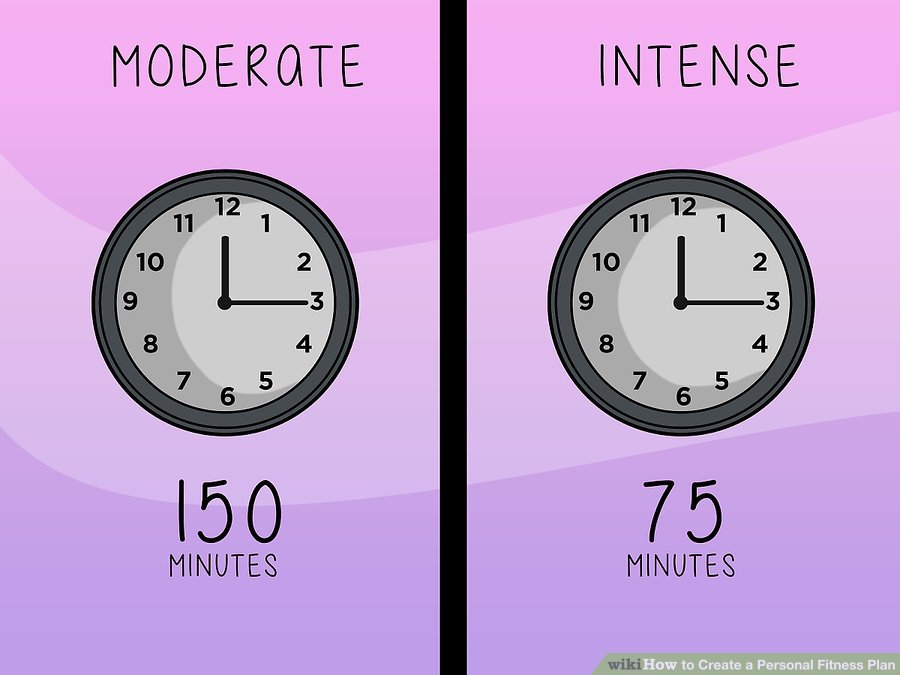
Start slowly. Ease your way into the routine until you have more endurance. The US government recommends at least 150 minutes of moderate aerobic activity or 75 minutes of intense activity per week. You don’t need to do all of this in two, three, or four sessions, however. Instead, spread it out through the week.
- Aerobic exercise should pass the “talk test,” meaning you should be able to talk and carry on a conversation while exercising. If not, your heart rate is too high.
- Ideally, you should do at least 30 minutes of activity per day. If you can’t manage that, try breaking up your exercise into smaller chunks. For example, go for a 10 minute walk several times per week in the beginning. As your body gets used to this, lengthen the walk to 15 minutes, then to 20, and then to 30.
- Don’t feel the need to do high-intensity exercise at the beginning. Go at your own pace. Otherwise, you might get injured.
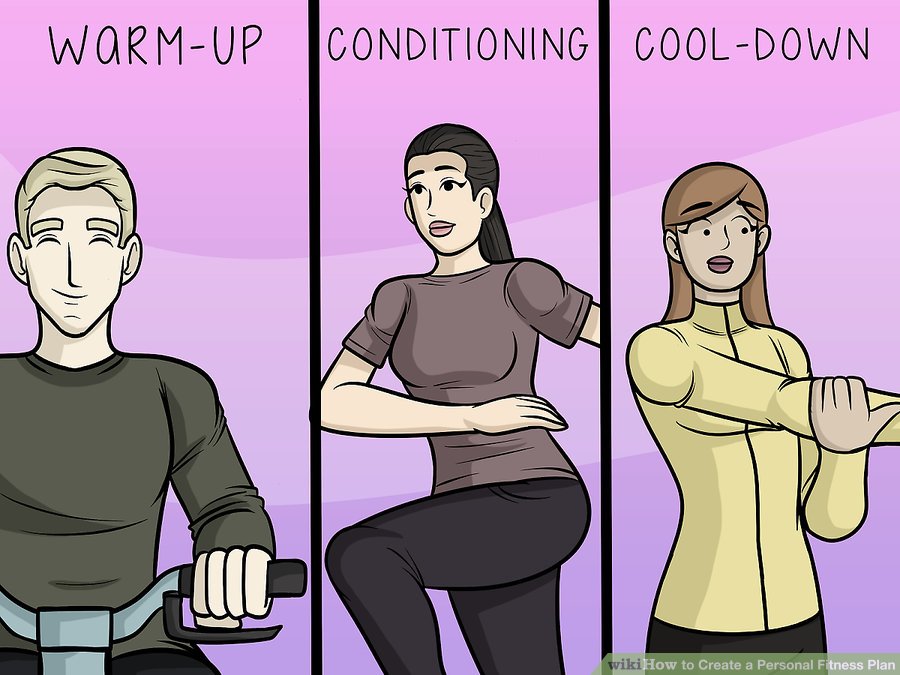
Use a three-pronged approach. Cardio isn’t all-out exertion all the time. To get the most out of each session, incorporate three elements into your routine: warm-up, conditioning, and cool-down. Ease into the workout, ride your plateau, and then slow down.
- Before each session, warm up for about five to 10 minutes to get your heart going and to increase blood flow to your muscles.
- A low-intensity version of your exercise should do this. If you are riding a bike, for example, take a leisurely ride for a few blocks. If you’re swimming, do two or three laps at half pace.
- Aim for around 30 minutes of conditioning after your warm-up. Conditioning is about reaching a “sweet spot” — a level that you can maintain but where your breathing and heart rate are higher than normal.
- End with another five to 10 minutes of cool-down. Slow yourself to a stop and let your heart rate come down. You can also stretch your main muscle groups, like your hamstrings, calf muscles, chest, shoulders, quadriceps, and back.
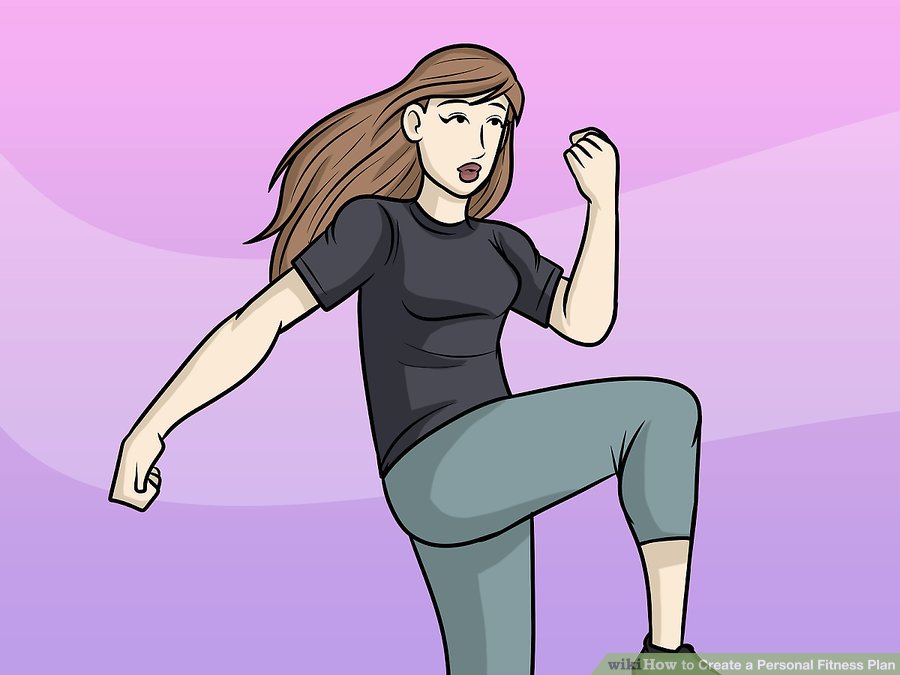
Work up to ideal length and frequency. Take stock of your progress after a few weeks and make adjustments. Chances are that you will be able to work out longer and harder, gaining aerobic capacity and endurance. Try to work up to doctor recommended guidelines: again, at least 150 minutes of moderate aerobic activity or at 75 minutes of vigorous activity per week. Ideally, you should aim for at least 30 minutes of cardio activity every day.
- Adding five minutes to your workout per week is a modest and doable goal. This means that at the end of a month, you’ll be exercising 20 minutes more.
- If your goal is weight loss, you may have to push yourself harder or adopt harder exercises. Rather than working out for 30 minutes three or four times per week, go for 45 minutes five or six times per week.
- Some cardio exercises are better than others if your goal is weight loss. Aerobic dance (like Zumba) and cross-country skiing burn about 700 and 600 calories per hour, for example, compared to brisk walking (150) or golfing (350).
- That said, listen to your body. Take a break and let your body recover if you feel run down. Stop exercising and talk to a doctor if you feel pain, dizziness, or shortness of breath.
Part 3: Training for Strength
Learn good form. Strength training, also called weight or resistance training, is a different kind of exercise. Strength training builds up muscles and endurance. It will make you stronger, strengthen your bones, raise your stamina, and give you other mental and mood boosts.
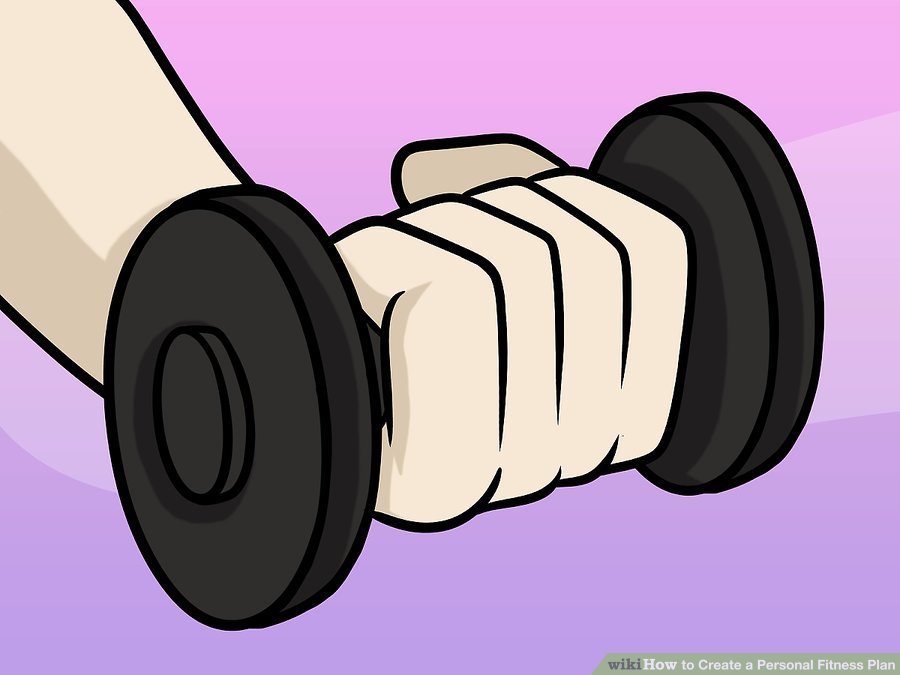
The key to a good strength program is to work big muscle groups like the legs, arms, and core.
- In strength training, you use weights to create resistance and make your muscles work harder. You can do this with weight machines, free weights, exercise bands, or even just your own body weight.
- The resistance puts stress on your muscles and joints, so it’s important to learn and always use proper form. Otherwise, you are at risk for sprains, strains, breaks, or overuse injuries. In general, you’ll want to maintain good posture to protect your spine.
- Start with a weight that you can lift comfortably 12–15 times (whether that's on a machine or free weights) and move the joint through its full range of motion. Breathe out when you lift the weight and in when you lower it.
- Talk to people at your gym. A sports trainer or fitness specialist will be able to walk you through each exercise to be sure you’re doing it right.
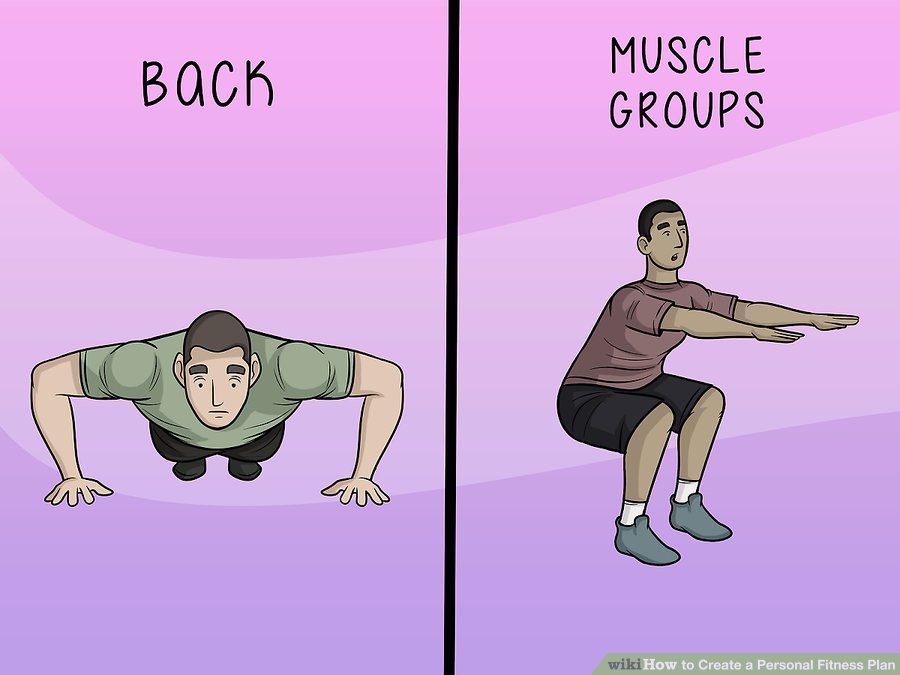
Pick exercises for major muscle groups. A good strength program will work all the major muscle groups. Choose exercises that isolate these or work several groups together. Tailor your program to your own needs, but also to your physical limits. Take into account your strength, balance, and age.
- For example, good exercises for your upper body include pushups. You can strengthen your arms and shoulders with bent over dumbbell rows and overhead presses. Bench presses will work your chest muscles.
- Exercises that use several muscle groups at once are really useful. For instance, squats will exercise your quadriceps and gluteal muscles at the same time. Lunges are another good example of this kind of exercise.
Split the program into rotations, sets, and reps. Your training program should be a cycle. Plan to focus on certain muscle groups on different days, and each day doing a number of specific exercises. You don’t need to do a whole body workout every time.
- Your rotation might look something like this: bench-presses, rear flyes, push-ups, and planks one day for your back, bicep and tricep curls another day to work your arms, and squats, lunges, bridges, calf raises, balance exercises, and leg curls for your legs the third day.
- During each rotation day, split up the exercises into sets and reps. A “rep” is one full motion of the exercise. A “set” is a series of consecutive reps.
- How many reps and sets should you do? Answers vary. The Mayo Clinic recommends one set of 12 reps for each exercise. Another rule of thumb is that light weight with many reps builds endurance and muscle tone, while heavy weight and fewer reps — but lots of sets (five or more) — builds strength.
- How long should you exercise? The answer is not that long. Most people will see results after about eight weeks with two or three 20 to 30 minute sessions per week, covering all groups. Prevent plateaus by changing up your routine every eight weeks or so.
- Remember to give your body time to rest and heal: always schedule at least 48–72 hours between sessions for each muscle group.

Use the three-pronged approach. Like cardio, use a three-stage approach in your resistance training: aerobic warm-up, post-lift stretching and cool-down. These will help to get the blood flowing, the joints limber, and to stretch and relax the muscles after you are finished.
- Do a few minutes of low-intensity cardio before you hit the weights, like walking or jogging. “Warm” muscles are less prone to injury than “cold” ones.
- Do not stretch before resistance training.
- After your workout, take some time to cool down and stretch (one or two minutes for each muscle group).
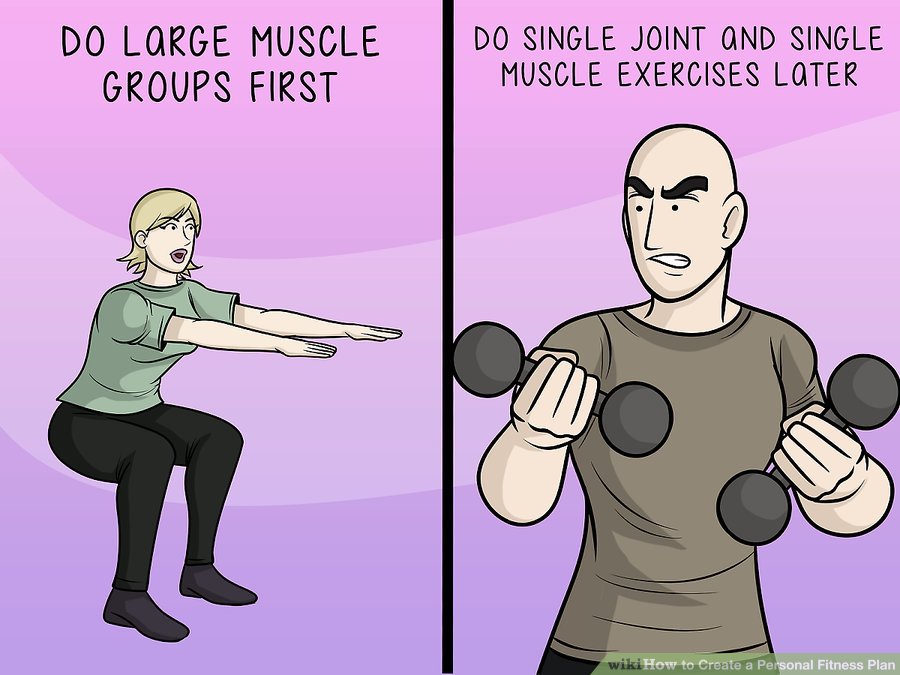
Do large muscle groups first. Experts recommend that your order of exercise should start with large or multiple muscle groups. That way, you’ll be able to do these harder exercises will more energy. You can isolate smaller or individual muscles afterwards.
- Prioritize exercises that use several muscle groups at once. Also, do exercises that use multiple joints before those that use one joint.
- You might work out your legs and back first, for instance. Squats, for example, use your legs but also your gluteal and core muscles, and should be done early in the workout.
- Do single joint and single muscle exercises later. Bicep curls or shoulder shrugs can come later in the workout session.
Part 4: Adding Stretching and Flexibility Exercises
Focus on major muscles and joints. Flexibility sometimes gets a back seat in exercise programs. Still, you should be sure to add basic stretches to your program.
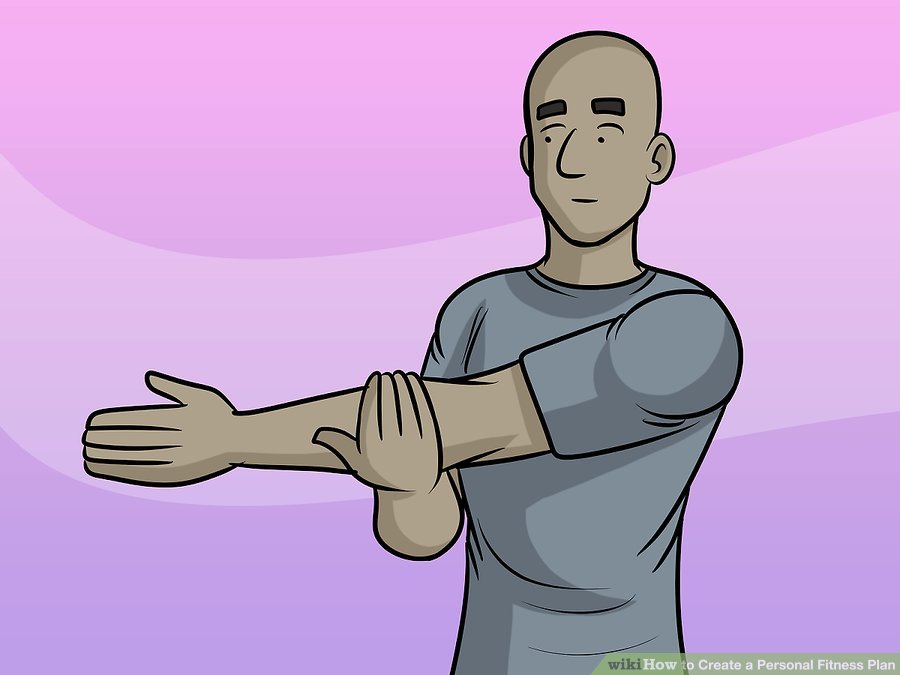
Stretching makes you limber, increases the range of motion in joints, increases blood flow to muscles, and can prevent injury. It can also help prevent postural problems and joint misalignment problems.
- Stretch major joints and muscle groups that you use everyday, either during your workout or daily activities. The legs, arms, back, chest, shoulders, and hips are some common ones.
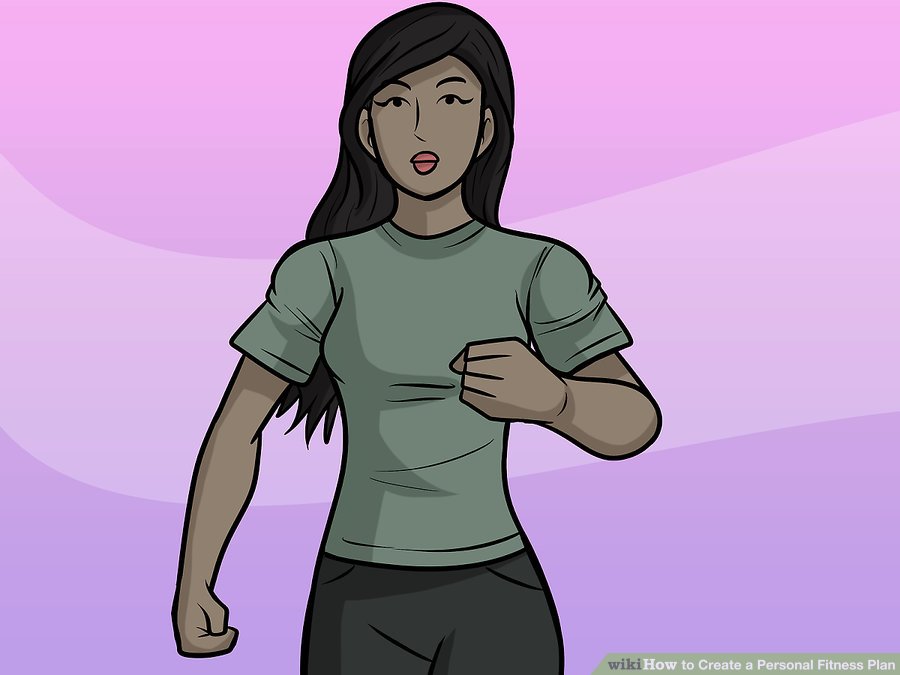
Warm-up beforehand. Don’t stretch with cold muscles. You can injure yourself. Instead, do a few minutes of warm-up cardio to get blood flowing before you start stretching.
- For example, walk, bike, or jog at a low intensity for five to 10 minutes beforehand. You can also stretch after your workout, when you’re already warmed up.
- You might want to hold off on stretching before strength training or intense activity like running or other track and field sports. Some research shows that pre-event stretching can actually reduce your performance.
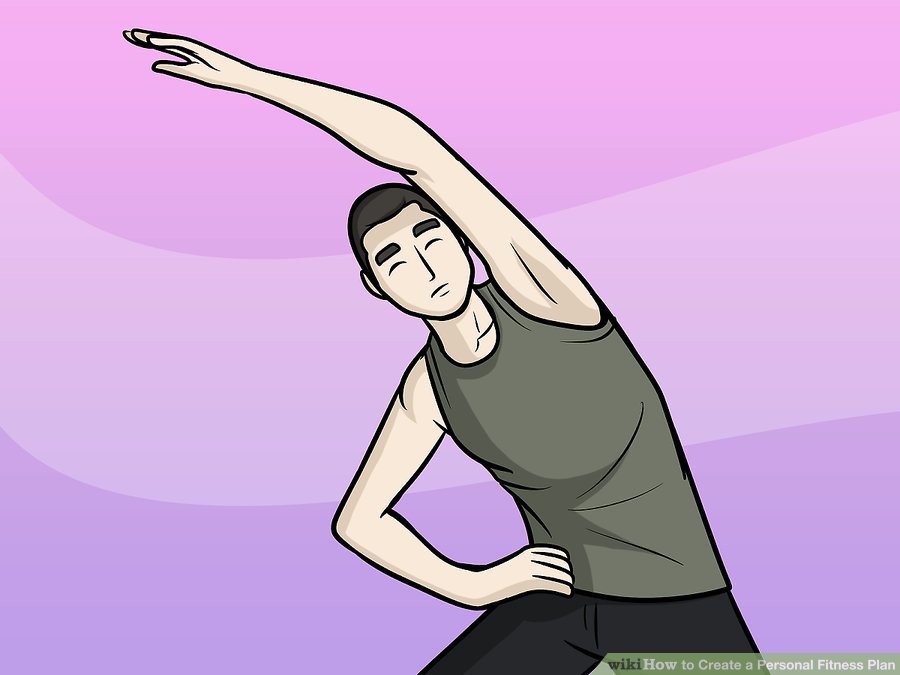
Hold the stretch. When you stretch, gently pull the muscle and joint in a smooth movement and hold it for about 30 seconds. You might need to hold for 60 seconds in problem areas, i.e. areas that are inflexible or tight.
- Try some yoga poses, too. In the simple balasana pose (or child's pose), kneel on the floor with your knees slightly apart. Then, lean your hips forward, touch your forehead to the ground, and hold your abdomen to the thighs for 20 to 30 seconds. Reach your arms out in front of you. This pose will gently stretch your lower back and upper body. Older adults should be cautious about this stretch, as it can be harmful to the spine.
- Don’t hold your breath when you stretch, but instead breathe into the movement. Also, don’t bounce. You should not be bouncing to reach farther. This “ballistic” stretching can tighten the muscle or, worse, cause injury.
- Be aware of your spine and don’t stretch it too far in an abnormal direction. The same goes for other joints – keep them soft and do not lock them in position.
- You should not feel pain when you stretch. Some tension or discomfort is normal, but if it hurts you’ve stretched too far.

